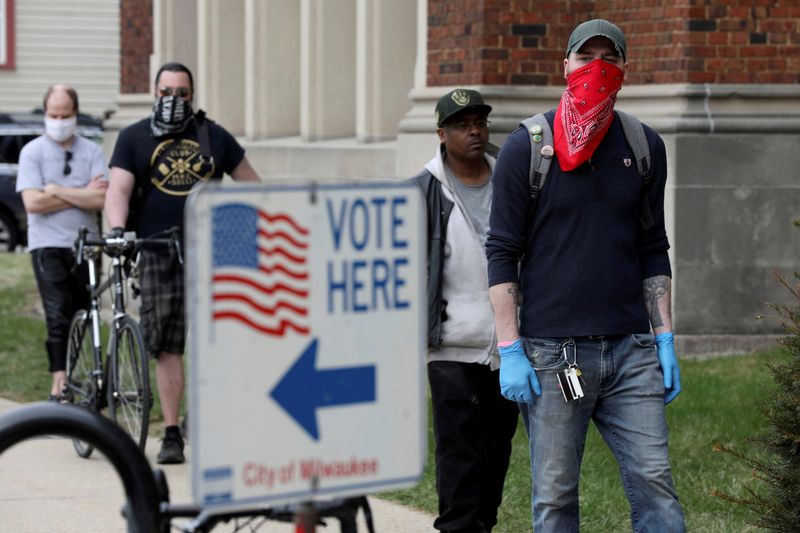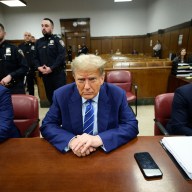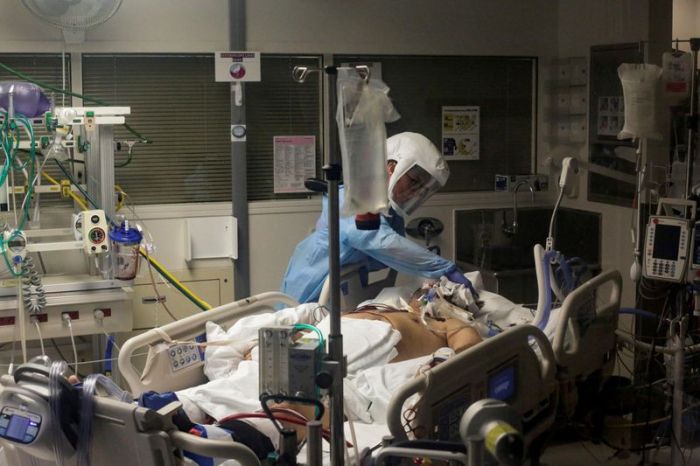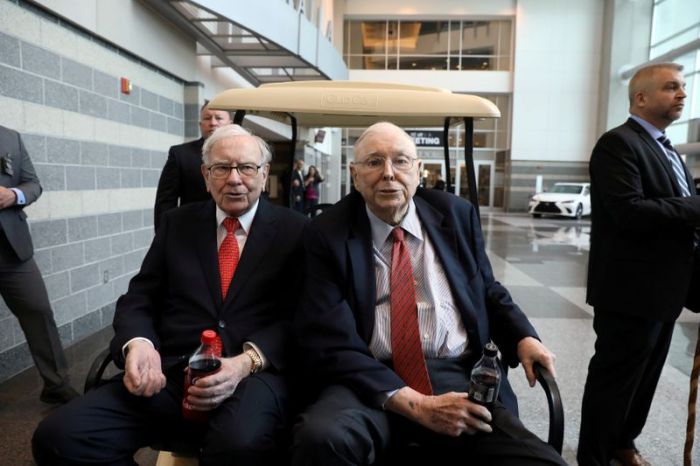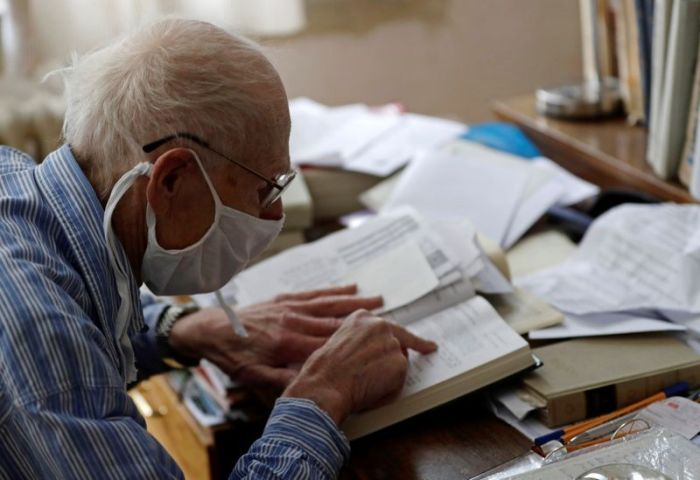WASHINGTON (Reuters) – Ohio will hold its primary election on Tuesday, a virtually all-mail contest that could serve as a test case for voting in the coronavirus era.
Citing public health concerns, the state’s legislature moved back the date of the primary, originally slated for March 17, to April 28 and sharply curtailed in-person voting.
It’s a glimpse of what the presidential contest might look like in November if COVID-19 remains a threat. But some voters, election officials and voting-rights watchdogs are already alarmed: Ohio’s system has been overwhelmed by the crush of requests for absentee ballots, a situation that could disenfranchise potentially tens of thousands of voters.
“I’ve been here 20 years and I’ve never seen anything like this,” said Brent Lawler, a manager at the board of elections in Cuyahoga County, home to Cleveland and more registered voters than any other Ohio county.
More than 1.9 million Ohio voters requested to vote absentee in Tuesday’s primary, a 421% increase from absentee turnout in the 2016 primary, according to state election data.
The state’s election offices were required by law to mail ballots to any voters whose applications they received by noon on Saturday, April 25. At least 37,000 absentee ballots were mailed out on Saturday, county election data show.
But many of those ballots likely won’t arrive in voters’ mailboxes in time, the U.S. Postal Service warned in an April 20 email sent to election officials in Ohio’s 88 counties that was reviewed by Reuters. Voters must return their absentee ballots with a postmark no later than today for them to be counted, according to election rules laid down by the legislature.
“There is a strong likelihood that the timing for mailing out ballots may not allow adequate time for voters to receive the ballot and return it by mail in time to meet the state’s postmark deadline,” the U.S. Postal Service email said.
Ohio initially restricted in-person Election Day voting for tomorrow’s primary to the disabled and anyone lacking an address where they can receive mail. The Secretary of State on April 17 advised election officials to allow voters who did not receive their absentee ballots to cast in-person provisional ballots, which must be evaluated by officials to ensure their validity.
But there will only be one polling place in each county, making them difficult to access for many residents and raising the prospect of long lines. By contrast, Ohio had more than 4,000 polling places in the 2016 and 2018 general elections, according to the U.S. Election Assistance Commission.
Columbus resident Carly Young said on Sunday she was still waiting for her ballot, despite sending in her application on April 13.
The 40-year-old, who says she typically votes Democratic, said the errant ballot has raised her anxiety about the same thing happening in November.
“In some ways, I’m glad it happened this election, because next election–oh my gosh, I don’t know what I would do if I couldn’t vote,” she said.
Ohio voters have picked every winner in the presidential election since 1960. The electorate is viewed as a cross-section of American politics, from culturally conservative Democrats who defected from their party to support Republican Ronald Reagan in the 1980s, to suburban soccer moms and upwardly mobile Latinos.
Democrat Barack Obama won the state in 2008 and 2012. But Republican Donald Trump’s eight-point victory over Hillary Clinton in 2016 illustrated the depth of Republican support in the state.
‘TSUNAMI COMING’
The national political stakes are relatively low on Tuesday. Democratic presidential candidate Joe Biden is expected to cruise to an easy win in Ohio after Bernie Sanders, his only remaining rival, dropped out of the race earlier this month. Republican President Donald Trump is his party’s presumptive nominee.
Still, Ohio’s primary has revealed structural gaps in the state’s ability to run an all-mail election in November if the country is hit with a second wave of the deadly coronavirus this fall, as many health experts fear.
“We are extremely fortunate that this is the primary election,” said Catherine Turcer, executive director of the Ohio branch of Common Cause, a nonpartisan watchdog group. “If this were happening in November–and you can imagine the tsunami coming at boards of elections in November–they just couldn’t manage.”
Ohio’s struggles illustrate the challenge facing the rest of the country to transform election machinery at lightning speed to protect voters from coronavirus.
Democrats are pushing more states to offer “no-excuse” absentee voting, for example, which Ohio has done since 2005. Seventeen states, such as Texas and New York, require voters to cite a reason for requesting an absentee ballot, such as illness or travel, according to the Brennan Center for Justice.
The fact that Ohio, with its many years of easy absentee voting, is now struggling to meet demand shows why other states with less mail-in ballot experience need to start planning for November, said Edward Foley, director of the election law program at Ohio State University.
“Ohio has shown that even a state with a history of no-excuse absentee voting can get blindsided,” Foley said.
In Michigan and Pennsylvania, pivotal battleground states that just in the past two years began allowing no-excuse absentee voting, officials say they face a significant shortfall in funding and resources to handle a likely surge in vote-by-mail demand in November.
Jocelyn Benson, Michigan’s Secretary of State, a Democrat, expects about 2 million residents to vote by mail in November compared to 1.25 million in the 2016 election.
“I think we’ll certainly meet that, if not surpass it,” Benson told Reuters. The state coped with a surge in mail ballots in its March 10 primary by staffing it “like it was a general election, but she said, “that’s not going to work again for November.”
Wisconsin, another swing state that was decided in Trump’s favor by less than a percentage point in 2016, also offers no-excuse absentee voting.
But nearly 1.3 million voters applied for absentee ballots for Wisconsin’s April 7 primary, overloading state officials accustomed to issuing only a fraction of that number. At least 1,900 voters reported not receiving a ballot by Election Day, and hundreds of others may also have received theirs too late.
‘CONVOLUTED PROCESS’
Mail-in voting has become a highly partisan issue in the United States. Democratic lawmakers are pushing to expand it to keep voters safe during the pandemic. Many Republicans, including Trump, oppose such a move on the grounds that it could invite voter fraud, allegations that are not supported by evidence.
Ohio, whose governorship and legislature are controlled by Republicans, falls somewhere in the middle.
Both Republican and Democratic legislators unanimously supported moving the state’s primary to April 28 and converting it to an all-mail election.
Ohio offers more flexible voting opportunities than many U.S. states. In addition to no-excuse absentee balloting, it opens polls well before Election Day to allow early in-person voting.
But Ohio has other hurdles that make voting by mail challenging, according to state leaders and voting-rights advocates.
Voters who want to cast a mail ballot must first fill out a paper request form and pay the postage to mail it to their local elections office. Upon receiving a ballot, voters can mail it back in a pre-paid envelope or drop it off in person.
Secretary of State Frank LaRose, a Republican, has denounced the system as “a convoluted process that may take weeks,” in testimony before the state Senate last September. He proposed sending applications to all eligible voters to make the process easier in the midst of the pandemic.
The legislature rebuffed the request, a move criticized by voting-rights advocates, who unsuccessfully sued to compel the state to send absentee ballots to all eligible voters and push back the election even further. Voting-rights groups argued that the tight schedule would be insufficient to retool the election for an all-mail format.
On Thursday, LaRose wrote to Ohio’s U.S. Congressional delegation, citing reports that mail delivery was taking as long as seven to nine days. Warning that “many Ohioans who requested a ballot may not receive it in time,” LaRose asked the delegation to assign additional staff to U.S. Postal Service offices in Ohio and “conduct a thorough search for unprocessed mail.”
John Fortney, a spokesman for Ohio’s Republican state senators, defended the timetable set down by the legislature, saying that voters were given several weeks to request ballots.
“These are extraordinary times, and although some people aren’t pleased, it was the best path forward,” Fortney said.
The tight time frame and surge of ballot requests has stretched Ohio’s system like never before, said Aaron Ockerman, executive director of the Ohio Association of Election Officials.
County elections boards, especially small ones that typically have four or fewer workers, hired temporary workers to help handle the deluge, which has kept officials working “seven days a week, morning, noon, and night, to keep up,” Ockerman said.
Meanwhile, a bill that would enable voters to request absentee ballots online has sat in Ohio’s statehouse since September.
State Senator Theresa Gavarone, a Republican who introduced the bill, said she was still hopeful it would pass before November, though the legislature has not formally convened since March.
(Reporting by Julia Harte in Washington; Additional reporting by Michael Martina in Detroit; Editing by Soyoung Kim and Marla Dickerson)

